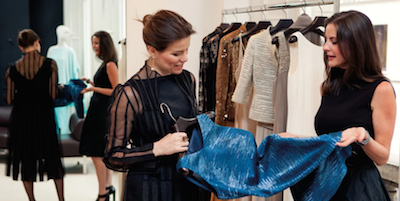Formal listening programs are effective but heavily underutilized, according to new research by the Shullman Research Center.
Only 25 percent of polled executives have implemented listening programs, but more than two-thirds say it has had a significant impact. Running a business requires big-picture thinking and considering growth from several different angles, but brands must not lose sight of the consumer in the process.
“Listening to luxury consumers really pays, and the truly organized listening programs deliver increased revenue, expense and efficiency savings, more marketing opportunities as well as enhanced profits,” said Bob Shullman, founder/CEO of the Shullman Research Center.
“If an organization doesn’t formally listen to its consumers, it may be doing or delivering something that increases its expenses that its customers or prospects don’t value and could be eliminated without affecting anyone, thereby increasing the organization’s profits,” he said.
All ears
Shullman Research Center collaborated with the Luxury Marketing Council and Peppercom to create a survey for C-suite executives in the luxury business about the implementation and effectiveness of formal "listening" programs. The results were presented at SenseUp Marketing Forum in New York on April 14 at a summit focused on bringing each of the five senses into marketing.
Asked whether they had formal listening programs, only 25 percent responded in the affirmative. Among that subset, 90 percent reported their staff personally interacts with customers and prospects and 88 percent research customer prospects and needs. The listening program also extended educating or rewarding customers (71 percent) and integrating distribution channels (41 percent).

Westfield London sales associate and consumer
Among these executives, one said that it “brought to our attention areas for consideration not previously considered.” Taking it a step further, another said, “It actually is the basis for our strategy.”
Fifty-one percent of C-level executives say that their formal listening program has had “a major impact,” on the brand, while an additional 17 percent go so far as to say they owe success to their program. Only 2 percent of respondents claimed a listening program had no effect, while 86 percent said they made changes to their organization based on the results.
Comparatively, informal programs were less successful, while those that reported results directly to top executives led to benefits for the consumers first. Benefits to the consumer then translate to higher revenue and more efficient and cost-effective operations.
At the end of the day, the biggest thing that draws a consumer to a brand is that the brand offers, in product, service and more intangible dimensions, what the consumer wants. By opening up to exactly what the customer wants, a brand stands to ensure it does not lose her to a competitor racing ahead and stands to bring in new ones as well.
Customer-first mindset
Similarly, as marketers look to effectively appeal to consumers, a strategy that takes all five senses into consideration is the best approach, according to a December 2015 report by Shullman Research Center.
Sight may be the most important sense, ranked highest by 84 percent of consumers, but the other four also play a major role in consumers’ purchasing decisions and perception of a brand. Luxury brands in particular should take note of the senses outside of sight, as luxury buyers have less of a focus on sight than those who do not indulge in luxury (see story).
Similarly, other reports have shown that focusing on connecting with consumers and building relationships rather than putting sales first will lead to higher revenue in the long run.
Besides empowering sales associates to build relationships first and then let sales arise naturally rather than push hard for sales right away, and independent, trustworthy outsiders need to become a part of the service model, according to the Luxury Institute.
When sales associates are trained in workshops, the share of associates that use the best practices after six months is a mere 10 percent. With ongoing support and weekly training sessions of half an hour to an hour, the number jumps to 95 percent (see story).
"If an organization doesn’t formally listen, it very likely will not find out about innovations or changes its customers or prospects would potentially value and gladly pay for that would increase its revenues and profits if the changes were made," Mr. Shullman said. "Either way, not formally listening to customers and prospects, we believe, is not a smart organizational practice."
{"ct":"3Us1j0o0v9UvV6o8uDnFfkYDSXYteHBYa\/FmAHOj3OKYyhmLI5BfrJsMGHJwByCIskAxMkVGm2hnEqHhlpROQ9a1ttJNImn3CfWE9C9HyjOyKAm\/adt3PcXc25yoaqqA9KGZxdjsLR4LJBsHxLsqrg+AHURHhZ87sXAPpNmUL6Tbg9DmGhahid2OTv7LgTHLE2lg4EIpKe6LqNajPh9KTAHKO2daMUlFlERQ4roiC13S2VmMfEeHZMQJ0N8zRUGIk+xSTlycbPcg0Ri6RWH\/6vjafCzMjaw1\/uTVH8f3YtKa1BPaggNIF5kE8Ra7F4GFSgOxRXYDeT7YsD\/KjYATuxcSHOBi4r+c6JJdId+l6CmLpoGXcXeYvdSAIyJIunCECtx6DzevUzne4UO6rXaS7sN9HpwGdEtt5Z6h4R8Xx2iyX8qDgqkHTuNyqUuJidzZg04KusWnB2LTnndNV0vMzFUEZGpy4ku5OUovlRdIKSz51MYCtuPPnLz3CxIgo7gV9qi2CMMMtEz4Gh\/HhRXJODiG6PNgsEyn05cxE9ylqAKnhR+2CVYEO5ciTDC7xLN8oN85D6e27Sjv7HwU6nUXVGeJ1\/0d8Q7gDHSSxW5fZDoCcuyrx0Yn2h2KnFaVqAFeo4Bz9w1rcb6klW4+pETauUVHp37mdxriUWIcJjRs5Pq+LtqhVi\/PydSDy3fU5Qxu5JECnjaYpMttxW5GxEMygpwpdsUW1DzSRZ07WBeIhgqiW3UTvBPQajqqvTxx\/WSF0mZQbcVdMh5pFBprOgzvQ\/vw5Y3Uilusc1WozFIPH+m4zCStYcIw7jsUITjqJf9zAoUmsR0AQogZ1C3HyeiSnfg7X6TCyDhq0SZtPc+LpEPRSk3THHqFdvoYHNmK0ZSc5ZoovwPV3gDrhUAEPKMlVdRnL\/Z+AyhOfnNxDSZSJcOihlrJpn8OLLT9vtgKcC0bDdVTH39NDFFKloufEU9J60IV0\/aTWNG4i8BVxuhtr1uDnfeIihCVokY7zlv9s8KpNl3dZj7noeKdLMgYnnyfTg3V+JtV+NF+jekBDet2qFT+xhbcrmfocYcm8axgMHRabJ+Czwu9OwCnq6S2UfHmSSw2b9qTtEaJGgfaXIYnFz0mOBUTyb2KzrrUsTqU2SO9\/dCYp2QSYniMq7NoHuU7v0a+RN3Pi+1tFHuLtbx4XozeO2kQ40SLCIkvdj7At+8+ljXwQgey6dSzZ0lUwhFa1gR2vS+r4vSssNCNDqXHEke2tgpZ+srGhcuecclEBHWUMr5xQTy07EtGdfOxxFUNchgbkMB02izvAWCX+Y5+nJ38DiG7+MPPgwqmFcl1K\/VHq5GpZaqp5YPCI8sG0WjPE5Q7KydnXe\/l3v+epQxDEMvJd\/ZhbaIp5a7NElzDArWytxIJ86p4BuDiFcljaiQZ1nB1d\/kpP0auqOt9dEgKbM2g6JSZsuTPyQ6U3cdFOEdZXzPw5l9QnazX9PKug9MVqpo6YrA7pa1sY+\/jxC\/kCDFP7JZLxz4DA9ils67erywiEC3dB8PK0S9MKVbaiByZAmWKja37olUP2AtNnmoPC45LnDM2fUKiYLUxG3hnaszssVY6fvon7bQ7VZm1J90UB2VPGiZzUMJHd9acT9hgnxJXl86a2ul0xFZm2CoixzZ842m5qzhPHmI1fODcx8RnMWKFQA3bq+xjpbwTaFpSuQ+ZpwJ0RRMAyZtSY1jEuTvtpb05F\/yDtREV+H+iw5v92og7qwE07GI+5Ghm9UX7pr3imF0ZpE7pBWbpjyMEfVn8jEEobcwd950R8wZx\/mgYxojoE81cuD8ahVfHw\/JHYisvGTzk2CuuoD74qHmcYxiEFvs8BXfJRgdvrDZrU8N61DrY1Kr97TA\/bYYeszqKYEd5iQw8fy9\/pbWr72NEmhm9HHTdtK5JJ8pc3ezFvZZMJFzA6M0rLqVdMEzL4JlT+\/K1YK986ImdEduqaHMktAvD2aI1XSNGOIsr2DR2SAKta+UyXknRffFCKBi5oOnj\/a4rcV0LmhYiA\/F+5KiUnjsOGlF\/RaIfso1p\/V2EHVVfCEdVwDWAUsF+HUNWylytsbTiaFz0lBXNP+c5SaG9YIECATiECSkAOE29AxK2YBej9OfpbqEc67PI\/ajURM6nf8c4PqLDpJ3nDjKhD0a8boolElk0knVrEo38S4SfXq9urcpKG4imMZuUby8ZOAm7JiKc0VjqWJI0rKvyyUJ8aJje1GxEFTMvs+A0bKSgRqYM919Xfx2iFJwKjb1W\/Ff3EIX8Z6nEKMfkJp6hw5eRZOXY9kfZRw2ShBo3UrBubeBXbsVzMpQSQjE770sVjfR2LQ+1z1l4o6Hz2oolWaUAoV+Ro8lrU\/TcUWBQjxLUVP1l2qbZ9XU\/P85npX+T3MQWtXuOKwAsClZ40cad2c5xUEd2DSgyf34FnyfR7HLd3lRBkrNiDJATpa82h5iVGInoCqcpA4dfZ6uPbI3kUTruF3U+KVY+xXHnJeYcAsV6TK\/ab5BJiQ4W8lAL1vkiXSCy2+nmIK6UoJvRsD0OCr+jaKzvYUQEhkPTeuXijv8DtsINbsl5jpMwSMn66aJdqZGKbb5ip\/dWHwPYCRtvKhIOn7CPTEj4A\/PUXgk6nhH0MG2QEcujMrwHfKXMc5r0pfyMDxEacXOJnHPvGONK6kbGVkkh53tXYz8e248yUonatKVn4udkrW6GCwy+zRO8vEra4+7LYTYRRMTAwOhtT66rCcHT\/TFYittdXQqX1FNUh+yVaS\/N4URYly155+ZKsSoBoJRPSbAidvXozSCRDGSMJ0YzIGIQYrNYQ6Fnt19lGbtIWnYJtrGcq3o3qUYUAlw1RocF1UDE+oGPGcknAN\/yCjjrLdcqzOyGpquChLcml+F3zXZo+CXt1Ed7+skA5dvcXzy1HeFH890JgKI53tgAeyd\/qmnFVa0zQ5pA6uGJvow0GL4vc1ZdMaF3yaKZ3zJj5ZxsoScotLJ9s4iZnoSII1AKnQsIDKxfiviv8gDa2ntY3nY1xgNYOondYMMh+K7lYI22ZPihqkEf97UDr6NHn18jnm9ZJ\/ae0HvA0tE3EfcbrYHf4bQg08qE8h7jtPjJt29gdpg3tfQVH3LPG16vT60CjqCguvxhHWiJmpYMoDdDyA07ZjtIAEDP46WFQusJIvK6K6sLIoARnHwrXxK30irggmWcDMU8JNoIWOsfV\/BPrSjW302uG6MGcRLRTgrCgfYbIumBeCmyqoq3uzwj5o+Jh4OygtORnylG+tJdJqjkmW7HB9LPemIz0VFxe\/e4FdqWZ631i2K2j+uL77AjkBX2gktey3LM5MFuyui3gRdNojUe2Zwsb5RMbXxNVEKxcVi+ZW5onvYhRxx5QusyED8Gmf58TZoIdYe9+wIZctelxqj4IClo94TXwdDA0HnZubCUHiQwbuj7Grcn4hawMdpzn4OxW\/x3Rkycx8gAOtosiWIWCkA7j5TeNg11YpWqDdMY2+TN6PI+8R8ACDZw8FM2IDeqoPfxhYRqA1FMrB7aqd5cWo+wOyLz7sUVBOPFvJRPXN2kDVM5iokEStDZw+s8EcdJ2ng6dHKjsNIPoxrexE0gDUiDaQLTcLMywbJeSXcDWN94jbPQ4dG362LgRq65hIp6WVcV0Bkv4e5oOKOirdit\/HbY+Kj0gbqUhWYkxdlLIKALOn9NAX0ffFVz1LX3ITkWEXRtL0FpdFAZh31FbpJ1pdxX3MM2Pz6jAS\/79EHTqUJs0HzEcSjJ5X4LuCHPVGBBxgNg6Z7LKtC4NeVB3iIWZHifYBZ1L43\/7dO5nAT8u0EuquUWZld1PpdK\/dQ6OnbqveQ8GuFntGKUWXfqWV5+3LgzLFgyPyviK\/yI4SFkuef7X9Q0tyo6C1GLtbFe7ILiLKFjPc0PUCIxTAb2nVj7i6wmEVaw47YHyQdc6KJUyJE9ocPmfUVGn3EHXHObPDyUF+Nk0yEkat52kBqW8s7G+WjfH9yxhMvv86gwwyTfk8lSZzOXjXX59uqjYzDdYxoXi\/0jxbpaNvgG+CjeWHKXPLD3RopFEOxmFBYN8qdRND0O3Rl+FtsRJM6cxWUxmgJ4kLfKuCvwvzFs+h9PVCj\/7p5+6inlghvSWGmSgAmuOx4wqhmbFbvhlShZY1T1g536iJv1HESJS6jpSrUD6iVHoIXD11qKBVxKhE\/pO\/V45ZsCNb4JRCHV4k+P7fKakDnMS1v4bDUfX9oMKwjUtqiYSUpUlN1AsPCPZfULeL0cXBzxJhQFPm4JzFOOFkP4Gk3fihASTN0WjU7I473IxBP3jRPOWxDUZk9VLLdPAXFf17i3A1IWAlEFHXt5+YQVJqhomP7AmJ6fn0Un\/sucokr7lFeKW29mq7M3oTTui3Z53lQfY7cPKZprlhAdiZQVamLLsroJXUxhCDtPXWDtoENW9MKpqSgjN7zCr1vaQwZsr0h3VqnjXdiEHbX5YibjTOaoZkmZc0MFv\/JSz\/eTuiEgDC5pCKRVtuA64YXo9gDwmFNKDyEEHkZH6SSwaE0e+bFIFdgm6DJCRZFux3dXHypBrvrt02wM0bKhEH0EsWH\/lnt\/+msG0JfZrBYEgBB\/BX0HUigoJRRB6cOWffPzWkRCzGHTgfZVExDWn\/kRY1zSIJR1wVNM6CefLRRrlJeg3uq5N8ut2wfqXWfRorNjvpv80wADVO743KFJmnTlj9PPNbBJpFgy1+apbH\/ffzO+IpSdB2kaoTGIWhgeatfgDOX+icEPz3wB0pVpmH\/vFn\/ncKigZrV9jirCCdOPZ3FjG7iln8gM+J5syN+\/fRYMU8mMfUCNQ2ld2vAU2xSl12FjWS6EcA+ANV7IENIKmwFbdrXnvcwgwuEFb9U7Un9dK6Q5vV9Cslhs3L9biccagEMBqxdYg8aKlm7kXg6AhFNwT6J4tRCn6nRlnY2+z0Jg8Wwg+x7tY+Pp+aHtWTb9mAWUE9hI5obnu2c6PbDFlLMa\/zJdVZu2KGnCvyFdKi8brqlm91NkRTpR59nBRogvDk6ZZ68DNv5CoOAa+EDrOZSvCuWMMseGQqvBkOrQNo9jRYfAr67aP7I640g3ph+Oox+5Dq2qm4f+R8wknvoxTF2gfzyzEXGJInRkOP9SG2OBO4jkygHa4UXGJxBSq0AhrT7mI07gk2HpIJl9LfQnMQLhjan3Ay8l1QEGAtoOSKBEXfovnRWQLUJloPRovPLnjI7Cm6S8E5wfVOrZi6zZI6xy76NUbCqAVmSLMBrZu2KsyureVW0m1ncaC3YI3G\/gjuGWhX\/wvAzLkD5gYICGpagDVzNyjo6vHmkyGJFVH6Ng5Uwu3kHhRrhm1raB+qAW3Tt6+j1fZNsx28P2OqLY2MtXGdf43\/ewm4p8A2VpDNiQ\/oHkzF7aqUuGPKDmGT1q0oxM2FjOlzmjmZm9bRivgmfB2opEliE0RWI2WD3XRL5Djr5H\/6\/6+PBMp0UBadNjWr3TMtk0dnbNKX72iaq7CegzrdX0roD1rzkduPoXG6OBebRCNcILXw4AOMJeLaLMZQaUcPIIPkm43N+jRHjLqN4h5fLOoe2ucfF02g+UD56iQd0fk4PGZKGu1s3ClgWeuXIpmEEDZxmajWrq9WPiDfOPOtzvZcmIsykYvGfkjCsdsr1fvh\/MUbSVddhCjnJ3OXeZHRjzo7D9zHkSiqFgdlmi71HSfUDMe+yHuOjctqcVAVPqxqUI6tI9rOTLQmnHuW5OBNenBKuuwj406xfdHFt23P3tdz1b4TboJkbNdGDhSBwW\/RHjJgA8gZ6hU5L0cPzmOebPpiGp5bDdNF1w60zH6bMGuHKTDiEk5qqSlXEwMu9B8kuAueAPV5uzz9pCB6+CUOri+PHeiUjhbsud0DEB7TKQsgDpPO7L\/fZjP1vn+Up5cF39a9U8mg36d86iqVz6\/5JBsOW2j8xEu8z8p4rJZJbRtW5LX3Wk2OwzFcuMqjUrjYkq6aIGoRIk0lAAxpVYs7FEJZ+OTuazO4z\/wZVrPXLJTxIuZuZ0q\/K5KiBw1Kv4Fvdg1TdXBBvFyvpGlbl3SwCCEb0u3ywRvamHTPbLQYDWizqJcOi1+eqRkrZsPBvJj\/Gk4dn0VJFwX8GX2xfCudnB5egPxOK0cZsxqfhThWpIrzSj28aM1X6C96q2jtHkwCvEONRef\/4HjUpMCDLTVslU4m7AyKNwt34W1laq+ZVPtImeDlDfzGZehtoKgfTHn2w5UIbobY0jvfQG2HI84LpDmO81Menr861V05YBQcT2jfw0Vr7tJ6\/06n0ibTIJaw4uGY4JxtqKCM3ydUtpCkMZWA40JmO3RxO6eok7mRhIV6Uhmtb6puLaEwpublrWaUaLlBl6afS9iUxGA5O3G2fbw\/VmdqBfaF8PLABCIWKCMfQTMJINh9AKq9mf18hKtM5clZiY8lWRHgfJc+AfHd3ip2RZDgsae43rD2qOFITZ0xB8pTk1gMIsJH6BdqyICZ8a4r1LG7u3k8M\/CBoWEj5PYTaFqsYsHn98uLZvUwvVFsUxDiAvEnqLmn+zLvTPsFBIbqSCVpn8C0X9lSU1lUXarLUCSX5zcpqTevRGvAdiiOcZuNXdG3+8eMD9Zc0IlvX0WZOtrwxDJMXs6tWPGi\/ecvApNHsNx2A0zWbJrcFmtu9l7hxuDI5hcD+uQvWNiSKi02yMxqMD7vGw9So5bG7DuLjZ+zkzW9HWboHIO0RxyvA04Cd2HSxa4MHoNc1TTXswVAJIh2f9wSiexd6nlakzA49Uu\/yvmoVAfi\/EW8xmkHCJ\/WUaop\/ycIdv4A64q1sSuV\/YvEFs2A46uGloBc2zqTCMT0kqVC5KbxODYK0dCziE\/JYWWv6v97\/VHyLQUy1PK\/GEpV+fIrqTfnjaxnZ7FH3KQmq1rTokl347vPjW0w4a6IpRMERzWHK6V61kyRfV63iGxEQUGiKEWSfYTFfQOEexD\/NVE+t9lhb+r6ZekQSAHQy0ZkN+C86y1oV3vkiotgNWORvDlzn+lqhG510xf8144rOvA7rBATjrZi4lxMZ7MRtbj7RVso1mUZxocS\/ARUwuY6EWmNVAH\/dTKTOKFhvYo6Y+lCMZLSZeLPep3589+HpeS3l+bdQ9dXWS5UqK6CmKBgjE8SwibSGENtL8WTn+U1XBibrH4Jsl922mxZFi8boF0P+vPkeGaPrNkZwK2dyfbKG20Hu23Fh+h42JeAFXK44ZrySDbM6B2s+lzVAv5206Dklwjt2kim4ykjpb6whUziMt9Bi2bCWC89ImoJ7LVk3sdXdgM632h38S++Pq9GmR\/uu7MVf9qLmscZ55N5hc3ZLThuQBwljDTzWf5jUEjyLUn837ZMcTdP5fgxnw3ejef3y53E+rnU9PVjNE7Dh9sAXRn2\/za6grQ1P601ZIkPTaU9WEMx74XOixu2gWic1hUKQqvHCIRPw7fjRXO6h3Y5Dp1Iag4UTKr1z\/bI+xRJHoynC6Kz1Oo2xVFQMIGRmICw8nMpVvM43Rrcr1gD38ClaIm1L3+fnOadrllGEk0738JR6TdTtvFHa+Fgfw7YSKUy1lr7bHX4PYfOlWKW97g50b42Mfm+W32Jlb3GKbg8XEjWa++iVmxfcp6X34J\/6IQjHQQE8REiwtf03rrm+9fZEgPUVa\/Fo5JRbFai\/0Hqa9k9WN5vPn","iv":"db161e3eb5716c226e184c12864893a1","s":"fc368bf940084935"}
